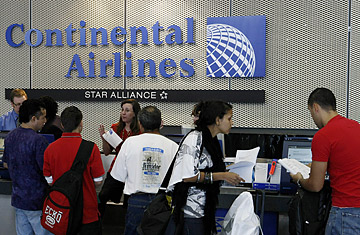
Passengers check in for a Continental Airlines flight in Chicago's O'Hare International Airport
The economics behind transportation are generally pretty straightforward — unless you're talking about air travel, of course, in which case it often costs passengers twice as much to fly half as far. The Avenger digs into the fuzzy math.
Offending Party: Continental Airlines
What's at Stake: $430
The Complaint: Let's say you're going on a trip by car, train or even burro. Logic would suggest that it would cost you more in gas (or hay, in the burro's case) to travel farther.
Not so when you fly, as reader Lee Wise found out. Wise, who lives in Youngstown, Ohio, recently needed to travel to Kansas City, Mo. He wanted to fly nonstop to his destination from nearby Cleveland's Hopkins International Airport. But when he checked Continental's prices, he discovered that the ticket would cost about half as much if he left from Pittsburgh, Pa., instead: $320 vs. $750.
The odd thing was, the Pittsburgh flight was not direct. It connected right through Cleveland, where Wise wanted to leave from in the first place. So, he wondered, why would the airline add an extra leg to his itinerary — and in the process, presumably incur more fuel, labor and other costs — and charge him half as much? Something didn't add up.
The Outcome: Wise called Continental customer service and was told that the airline must be trying to promote flights out of Pittsburgh. Maybe it's as simple as that?
"That's garbage," says Tom Parsons, founder of Bestfares.com and an airline expert. The reason flying out of Pittsburgh International is cheaper, Parsons says, is that the airport is served by discount carriers, including Southwest, JetBlue and AirTran. Cleveland's airport isn't. "Not having low-priced competition can as much as double or triple prices," Parsons says.
In the days before airline deregulation, ticket pricing was much more straightforward and was directly linked to how many miles a passenger needed to travel. No longer, says Parsons. Distance has little to do with how much a customer pays anymore.
A few years ago, what Wise might have been able to do was buy a ticket out of Pittsburgh, then skip that first leg of the journey and just hop on the connecting flight in Cleveland, thereby creating a direct flight for himself at half the price. However, with increased airline security, carriers track passengers much more tightly, and Wise likely would be red-flagged and not allowed to board in Cleveland for the second leg.
The Avenger asked Continental what was going on here, and spokeswoman Christen David, replying by e-mail, said the direct flight from Cleveland was more expensive because of "supply and demand."
"At any particular departure time, there are comparatively few seats available on nonstop flights compared to thousands of seats available on a range of connecting itineraries," David said. Nonstop flights are pricier also because "there is added value for the customer when he or she purchases a ticket on a nonstop flight — less time spent traveling, a better chance of arriving on time and with all your bags," said David.
So it turns out that airline pricing does boil down to geography — just not the geography that lies directly between your start and endpoints. If you don't mind flying out of your way, or if you're lucky enough to live within driving distance of multiple airports, always check fares for a variety of itineraries and airports. If you live near just one airport, you can always weigh the price of an exorbitant flight against another option: staying home.
